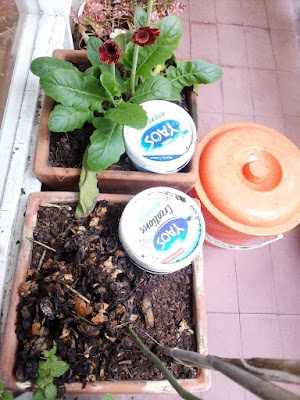Modern gardening is a sterile process, focused entirely on the plants, as if the soil is a mere tool, and insects an inconvenience. We go to garden centers to get what we want. Seeds, plants and soil are all packaged neatly for us to take home and put into the ground or pots on the veranda, as the case may be.
When our plants wilt, we either replace them with new ones, or we use chemical fertilizer to nourish them back to life. Either way, we go out to buy what we need. Gardening has been captured by corporations. It's no longer about sustainability, but about profits for corporations.
The result of this is that our gardens have become sterile fields where nothing lives except for plants that are kept alive by a regular supply of chemicals. Take away the chemicals, and our gardens decay into sad, lifeless deserts where nothing grows except weeds of various kinds.
However, gardening can be something entirely different. There's nothing stopping us from returning to the old ways of doing things, and my experimentation with micro-composts is proof that this is so. I've played around with this for two years now, and the results have been remarkable.
I've approached this very much in the spirit of Emerson. I've paid close attention to the various processes, and I've experimented with different approaches. The way I currently do things is different from how I stared, but not so different that we're talking about a complete about face. My current approach is merely the most optimal I've found so far, and I still make little discoveries, so things may change again. However, I will never revert to the chemical approach because the alternatives I've experimented with have proven themselves to be superior.
My current approach deals with the fact that micro-composters don't produce a finished product fast enough for me to simply dump the produce next to nearby plants. More composting is needed, and my latest discovery is that this can be done by digging a hole directly below the composter where the half finished product can be dumped.
 |
| Micro-composters and a bucket |
I'm not dumping the produce into a bucket as I used to. I'm dumping earth into it, only to move it over to somewhere else. The half finished compost goes into the hole under the composters where composting continues.
This means that the complete cycle for the composting now lasts twice as long as it used to. Kitchen refuse spends the first half of the cycle in the composters and the second half of the cycle directly below them.
This allows worms and maggots to work their magic twice as long as they used to, and the result has been a big increase in the number and size of the earth worms and maggots, which in turn speeds up the entire process because these creatures work their way up into the kitchen refuse in the composters.
The finished product is no longer sticky, with a faint smell of manure. It's black soil, crawling with earth worms. Needless to say, this doesn't belong in a bucket, because that would suffocate bacteria and worms.
The right place for fresh compost, brimming with life, is to mix it into existing soil. That requires flower pots with sufficient volume to allow for this, and my wife and I have acquired two plastic drums with drainage holes, partially for this purpose.
 |
| Plastic drum with drainage holes |
This is where the final product is dumped and raked out. Smaller flower pots are then put on top of this, to make for a lush look and feel.
Whenever I need soil for other plants, I scrape out some of the top soil from these drums, and our total production of compost from kitchen refuse is such that I'm never short on fresh black earth.
When I compare the earth produced in this way to that which can be bought in stores, I'm struck by the difference in color, feel and smell. Commercial earth is dry and lifeless, the smell is faint, and the color often brown rather than black. Digging into a flowerpot where such earth had been used over a number of years, I was struck by how the earth was more like sand than soil. The flowers in the pot had depleted the soil to the point that they died from a lack of nutrients.
Flowering plants like roses and bougainvilleas require a lot of nourishment, and cannot normally be grown in pots. However, with our household producing ample quantities of wholesome compost, our roses and other flowering plants are doing well. Our balcony is lush and green. There are hoverflies zipping about. There's life everywhere. It's a proper garden, the way gardens were supposed to be.
 |
| Under the bougainvillea |
No comments:
Post a Comment